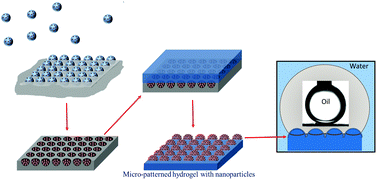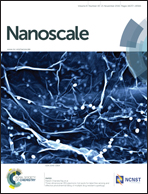Hierarchical patterning of hydrogels by replica molding of impregnated breath figures leads to superoleophobicity†
Abstract
The surface chemistry and topography govern the spreading of liquids on a solid. When an oil drop makes a contact angle, θ > 90° on a solid surface, the solid is termed as oleophobic. Adding roughness to an inherently oleophobic surface enhances its oil dewetting and can lead to superoleophobicity when θ > 150°. In this study, we introduce the concept of a two-tier hierarchical roughness on the surface of soft materials such as hydrogels by forming the patterned inverse replica of breath figure polymer films impregnated with nanoparticles. The directed deposition of nanoparticles in the breath figure pores is accomplished by an aerosol assisted technique that exclusively leads to deposition within the pores and filling of the pores. The inverse replica of such impregnated films exhibits a close packed hexagonally structured second tier of surface roughness which directly leads to a superoleophobic surface. Since these structures have well defined geometries, it is possible to estimate the contact angle by assuming a partial wetting of the oil drop in a ‘fakir’ state on the rough surface. The estimation is in good agreement with the experimental contact angle value. While the work demonstrates a facile method to impart superoleophobicity to a hydrogel surface, it also demonstrates new methods to imbue breath figure pores with functional materials that can be easily transferred to the pores of the inverse replica.


 Please wait while we load your content...
Please wait while we load your content...